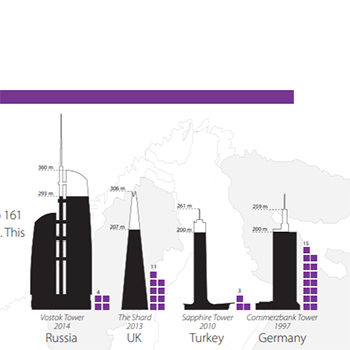Filter by
You must be a CTBUH Member to view this resource.
Naberezhnaya Tower Block C
Building
Completed, 2007
office
composite
268.4 m / 881 ft
61
5
28
8 m/s
136,651 m² / 1,470,899 ft²
You must be a CTBUH Member to view this resource.
You must be a CTBUH Member to view this resource.
Construction Start
Completed
Material Supplier refers to organizations which supplied significant systems/materials for a building project (e.g. elevator suppliers, facade suppliers, etc).
You must be a CTBUH Member to view this resource.
The CTBUH lists a project manager when a specific firm has been commissioned to oversee this aspect of a tall building’s design/construction. When the project management efforts are handled by the developer, main contract, or architect, this field will be omitted.
The main contractor is the supervisory contractor of all construction work on a project, management of sub-contractors and vendors, etc. May be referred to as "Construction Manager," however, for consistency CTBUH uses the term "Main Contractor" exclusively.
Material Supplier refers to organizations which supplied significant systems/materials for a building project (e.g. elevator suppliers, facade suppliers, etc).
CTBUH Releases Study on the Past, Present and Future of the European Skyscraper
1 June 2013 - CTBUH Journal
CTBUH Releases Tallest Buildings Completed in 2007
31 December 2007 - CTBUH Journal

01 June 2013
The Past, Present and Future of the European Skyscraper
CTBUH Research
There are currently 109 skyscrapers over 150 meters in Europe. This number is set to jump to 161 by the end of 2015, meaning that...

01 June 2013
The Past, Present and Future of the European Skyscraper
There are currently 109 skyscrapers over 150 meters in Europe. This number is set to jump to 161 by the end of 2015, meaning that...

31 December 2007
Tallest Buildings Completed in 2007
333 meters high with 72 stories and 480 suites, Rose Rotana Tower in Dubai leads the list of the 10 tallest buildings completed in 2007....
1 June 2013
There are currently 109 skyscrapers over 150 meters in Europe. This number is set to jump to 161 by the end of 2015, meaning that there are more than 50 projects in advanced stages of construction.
31 December 2007
333 meters high with 72 stories and 480 suites, Rose Rotana Tower in Dubai leads the list of the 10 tallest buildings completed in 2007. The tower, which is developed by Bonyan International Investment Group, is also regarded as the world’s tallest single-use hotel building.
Subscribe below to receive periodic updates from CTBUH on the latest Tall Building and Urban news and CTBUH initiatives, including our monthly newsletter. Fields with a red asterisk (*) next to them are required.
View our privacy policy